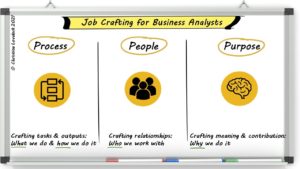Analyse Your Stakeholders
As a business analyst, aren’t you a bit like a translator? Your job is not just to interpret data, but to interpret it from the perspective of a businessperson and for the good of a specific business project. You are the middleman between sets of data and stakeholders in a business, and no matter what their educational backgrounds may be, those stakeholders are relying on you to deliver information that they can use to inform their next move. It’s up to you to communicate what might be rather abstract information in a meaningful, relevant way. Remember that word — communication — because as a business analyst, you are a professional communicator.
If you want to be a great communicator, it’s of paramount importance that you understand your audience. Forget the numbers for a second. Think about your stakeholders. If your job is to communicate with them, then for you to perform your job properly, they’ve got to be able to communicate right back, and be comfortable doing so. That means you need to be able to share bad news and be capable of disappointing people gracefully. It also means they need to be able to take that bad news and that disappointment, so they can work with it and mold it into success. Without honesty and transparency, your title isn’t Business Analyst. It’s Yes Man. There’s a time and place for Yes Men, but this isn’t it.
Speaking of titles, let’s set those aside. Your stakeholders may be your employers, but they’re also people. Shocking, right? Just like you, they will feel much more confident communicating with someone they feel a connection to. So to prime yourself for a successful project cycle, be sure to know your stakeholders. Or, if you prefer, analyse them.
Qualities of a Stakeholder
Think about the ground-level qualities of your stakeholder. Where do they live? This is important because you may need to account for time zone differences. Which medium do they prefer for communication — email, phone, video conference, in-person, or even text? What’s their experience like? Get a feel for your stakeholder’s level of experience, both generally and in relation to the specifics of your assignment. Have they been involved in similar projects in the past, and, if so, are they keen to offer their own insights? Don’t assume every suit is a novice with money; they may very well be just as knowledgeable as you, but, for reasons you’re not paid to understand, they’d rather not do what you’re doing. All the better.
Then comes the business side of things. How formal is your stakeholder? Not everyone is into casual communication in the workplace, especially when it comes to inter-hierarchical communication. Yet some will be put off by a rigid presentation. You have to get a grip on the amount of formality expected from you, if for no other reason than the need for you to be taken seriously and be understood as a communicator. While you’re at it, try and pinpoint exactly what level of authority a stakeholder possesses. While you must always be respectful to your employer (and they should be the same), you have to have some understanding of which decisions can be made by whom, otherwise you might find yourself unsure of who to turn to when project-halting issues rear their heads.
There’s always a shot-caller. Don’t shy away from a quasi-Machiavellian approach. Recognize that, in any profit-seeking organization, some parties are less dispensable than others, whether it’s due to their social standing within a group, aggression and energy, or sheer ability as a money maker. Identify the shot-caller and determine how their requirements of you may differ from their peers.
Peripheral Qualities
With the formality and infrastructural concerns out of the way, try a little bit to get to know your stakeholders’ personalities. Think of these as qualities you wouldn’t talk openly about in a work email, but that would still help you in how you decide to deal with your stakeholders.
Sometimes, your job might shift from translator to mediator. It’s not really in the job description, but, at the end of the day, you might be the only one in the room who can bridge the gap not only between information and business decisions, but between all the different arbiters of those business decisions. Stakeholders don’t always get along with each other or see eye to eye, and even those with deep, time-honed business relationships will bicker — sometimes childishly. Don’t be afraid to step in and resolve some differences, appropriately of course, if it means consensus can be reached and the project can pick up and keep moving. Of course, to do this the right way, listen to the room and note the relationships you see. Just like you analyse individual stakeholders, try to analyse the group.
You’ll find, after some time working together, that you can identify if a stakeholder is able to act on their feet confidently or if they are the type to ruminate before making big decisions. Keep in mind which one you’re speaking to, because it will have no small effect on how you proceed. Plan ahead for situations where you might get a committed decision later, or even sooner, than you had hoped.
And finally, this one’s important in today’s global, interconnected business world: culture. You will likely find yourself dealing with people from all backgrounds. People from different countries, different religions, and different upbringings. If you’re working abroad and you’re the odd one out, get a feel for the customs and norms of the native culture. That’s Traveling 101, isn’t it? If your stakeholders can see you’ve made even a slight effort to participate in their culture, it will be much easier to develop mutual trust and willingness to understand and work with one another. At the very least, you may avoid saying something embarrassing.





